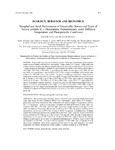Use este identificador para citar ou linkar para este item:
http://www.alice.cnptia.embrapa.br/alice/handle/doc/468701| Título: | Nymphal and adult performance of genetically determined types of Nezara viridula (L.) (Heteroptera: Pentatomidae), under different tempetature and photoperiodic conditions. |
| Autoria: | VIVAN, L. M.  PANIZZI, A. R.   |
| Ano de publicação: | 2005 |
| Referência: | Neotropical Entomology, Piracicaba, v. 34, n. 6, p. 911-915, Nov./Dec. 2005. |
| Conteúdo: | The southern green stink bug, Nezara viridula (L.), has several genetically determined types, three being the most common in Brazil: G (f. smaragdula - green body), O (f. torquata - green body with lateral and median lobes of the head and anterior margin of the pronotum yellow), and Y (f. aurantiaca - gold or orange body). Nymphal and adult performance of these types was studied at 15°C/1OhL, 22°C/12hL, and 29°C/14hL. Mean total nymph mortality in alI types at 15°C/ 10hL was high (ca. 80%), especially for type G (98%); at 22°C/12hL, the greatest mortality (55%) occurred in type G, and at 29°C/14hL in type Y (65%). In general, at combinations of higher temperatures and longer photoperiods, nymphs developed faster. Adult longevity of type G decreased from ca. 88 days at 15°C/1 OhL to ca. 57 days at 22°C/12hL and 29°C/14hL; for type O, adult longevity varied from ca. 81 days at 22°C/12hL to ca. 55 days at 29°C/14hL; type Y showed the shortest lifespan, in particular at the extremes of temperatures/photoperiods ( < 20 days). Types G and Y did not reproduce at 15°C/10hL, and type Y did not reproduce at 29°C/14hL; type O reproduced at alI three abiotic conditions.These results demonstrate that type O is the most adapted to the cooler temperature and shorter photoperiod, which explains its greater abundance in south Brazil. |
| Thesagro: | Biologia Inseto |
| Palavras-chave: | Percevejo verde Tipo genético |
| Tipo do material: | Artigo de periódico |
| Acesso: | openAccess |
| Aparece nas coleções: | Artigo em periódico indexado (CNPSO)  |
Arquivos associados a este item:
| Arquivo | Descrição | Tamanho | Formato | |
|---|---|---|---|---|
| 25874.pdf | 157,17 kB | Adobe PDF |  Visualizar/Abrir |









